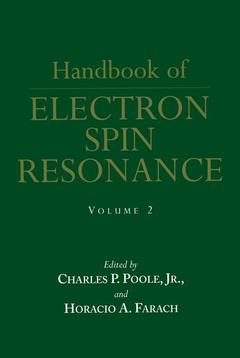Description
Handbook of Electron Spin Resonance, Softcover reprint of the original 1st ed. 1999
Volume 2
Coordinators: Poole Charles P. Jr., Farach Horacio A.
Language: English
Publication date: 10-2012
375 p. · 15.5x23.5 cm · Paperback
375 p. · 15.5x23.5 cm · Paperback
Description
/li>Contents
/li>
In the first volume, Professors Poole and Farach provided one of the first definitive reference tools for this field. In this second volume, the authors present a comprehensive source for subfields of ESR not covered in the first volume, including: * Sensitivity * Field Swept versus Frequency Swept Spectra * Resonators * Line Shapes * Electron Spin Echo Envelope Modulation * Hamiltonian types and symmetries * ESR Imaging * High Magnetic Fields and High Frequencies. Written by recognized experts in the field, and intended for students and researchers, these handbooks bring together wide-ranging data from diverse disciplines within ESR, and then integrate it into a comprehesive and definitive resource. An invaluable reference for all those involved in ESR research.
I. Sensitivity.- A. Introduction.- B. Minimum Number of Detectable Spins.- 1. Sample and Resonance Condition.- a. Lineshape, Hyperfine Splitting, and $$ S > \frac{1}{2} $$.- b. Power Saturation and Temperature Dependence.- 2. Resonator.- 3. Detection System.- 4. Magnetic Field Modulation.- 5. Additional Factors to Consider in Pulsed Experiments.- C. Predicted Frequency Dependence of ESR Signal, Noise, and Signal-to-Noise Ratio.- 1. Sample.- 2. Resonator.- a. Filling Factor.- b. Quality FactorQ.- c. Signal Intensity at Constant Incident Power.- d. Microwave FieldB1.- 3. Frequency Dependence of Signal Intensity.- a. Case 1. Constant Sample Size, Constant Loop Size.- b. Case 2. Sample and Loop Sizes Scaled as 1 /?0.- c. Case 3. Constant Sample Size, Loop Scaled as 1 /?0.- d. Comparison with NMR.- 4. Noise.- a. Source Noise.- b. Resonator.- c. Detection System.- d. Sample.- D. Performance of Real Systems.- 1. ~9.2 GHz, 3400 G, X-Band.- 2. Frequencies Lower than X-Band.- a. Below 1 GHz, Lossy Samples.- b. 1-4 GHz, L- and S-Bands.- 3. Frequencies Higher than X-Band.- a. 13.7 GHz (P-band).- b. 35 GHz (Q-band).- c. 95 GHz (W-band).- d. 140 GHz.- e. 170 GHz.- f. 250 GHz.- E. Definitions and Derivations.- 1. Definition ofQ?andx”.- 2. Derivation of Fundamental Detection Equation.- 3. Noise Factor for a Series of Amplification Steps.- 4. Frequency Dependence ofQfor LGR, Derivation of Equation (4).- 5. Frequency Dependence of B1Derivation of Equation (6).- Acknowledgments.- References.- II. Field-Swept Versus Frequency-Swept Spectra.- A. Introduction.- B. Lineshapes.- 1. ESR Signal Amplitudes.- 2. Distinction Between Resonance Condition and Resonance Center.- C. Applications.- 1. Adoption of 1/gScaling in Lineshape Function and Linewidth.- 2. Utilization of the Boltzmann Factor.- 3. Relation Between Field Modulation and Frequency Modulation.- 4. Explanation of Echo-Detected Two-Dimensional FT ESR.- D. Concluding Remarks.- References.- III. Resonators.- A. Introduction.- B. Waveguides and Cavities.- C. Coupling Structures.- D. Velocity and Impedance.- E. Rectangular Resonant Cavity.- F. Cylindrical Resonant Cavity.- G. Special Purpose Cavities.- H. Quality and Filling Factors.- References.- IV. Lineshapes.- A. Introduction.- B. Lorentzian and Gaussian Shapes.- C. Moments and Widths of Resonant Lines.- D. Overlapping Resonances.- E. Convolution Shape.- F. Anisotropicg-Factors.- G. Hyperfine Powder Patterns.- H. Small Spin Clusters.- I. Amorphous and Semirandom Distributions.- J. Conduction Electrons.- K. Exchange.- L. Saturation.- References.- V. Electron Spin Echo Envelope Modulation.- A. Introduction.- B. Qualitative Description of the ESEEM Experiment.- C. Comparison of ESEEM and ENDOR.- D. HYSCORE.- E. Outlook.- References.- VI. Transition Series Ions.- A. Introduction.- B. First-Transition Series (3dnIron Group) Ions.- C. Second-and Third-Transition Series (4dnPalladium and5dnPlatinum Group) Ions.- D. Rare-Earth (4f “) Ions.- E. Actinide(5fn)Ions.- F. S-State (3d54d55d54f7) Ions.- References.- VII. Transition Ion HamiltonianS.- A. Introduction.- B. Site Symmetries.- C. Spin Hamiltonians.- References.- Appendix I. Spin Operators and Their Matrix Elements.- Appendix II. Descent of Symmetry.- Appendix III. Site Symmetries of Host Crystals.- VIII. Transition Ion Data Tabulation.- Tabulations.- References.- IX. Evaluation of Spin-Hamiltonian Parameters from Epr Data of Single Crystals.- A. Introduction.- B. Perturbation Approach.- C. Brute-Force Methods.- 1. Variation of One Parameter at a Time.- 2. Variation of Parameters in Subgroups.- D. Least-Squares Fitting (LSF) Method.- 1. Introduction.- 2. Details of the LSF Method.- 3. Calculation of Parameter Errors.- 4. General Strategies to Achieve Convergence.- a. Use of Interpolated Fields.- b. Use of Interpolated Frequencies.- c. Use of Binary Chop.- E. Other Applications of the LSF Method.- 1. Electron-Nuclear Spin-Coupled Systems.- a. Estimation of Initial Values of FS SHPs.- b. Estimation of HFS Parameters.- c. Identification of Energy Levels Participating in Resonance.- d. Construction of the SH Matrix for ENSC Systems.- e. Absolute Signs of Parameters.- 2. Fitting of ENDOR Data.- 3. Angular Variation of EPR Spectra.- a. Computation of Initial Resonant FieldsHr(?).- b. Computation of First and Second Derivatives ofS’with Respect toHRequired in (31).- c. Problems Encountered in the Application of the LSF Method and Their Solutions.- 4. Calculation and Fitting of Line Intensities.- a. Intensity Operator.- b. Fitting of Line Intensities.- c. Normalized Intensity and its Derivatives.- d. Limits of Applicability of the Method.- 5. Evaluation of Noncoincident Anisotropic $${\tilde g^2},{\tilde A^2},\tilde D,\tilde P, and \tilde g_n^2$$ Tensors.- a. Spin Hamiltonian.- b. Eigenvalues.- c. Evaluation of SHP by the LSF Technique.- d. Numerical Evaluation of the Derivatives Required in the LSF Procedure.- e. General Remarks.- F. Discussion.- References.- X. Esr Imaging.- Tabulations.- Acknowledgments.- References.- XI. High Magnetic Fields and High Frequencies.- Tabulations.- Acknowledgments.- References.
© 2024 LAVOISIER S.A.S.




